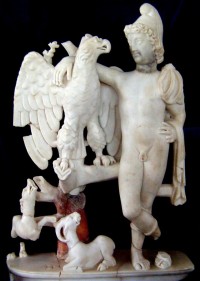 An extremely rare late Roman statue of Ganymede with his arm draped across the shoulders of Zeus in eagle form was stolen from the Paleo-Christian Museum of Carthage in Tunis the night of Friday, November 8th. The statue is 49 centimeters (19 inches) high and is made out of white marble. The museum has been closed to the public for some time but three guards monitor the building in shifts. Not exactly a daunting security cordon for a thief to break through at best, and at worst a handy way in the door.
An extremely rare late Roman statue of Ganymede with his arm draped across the shoulders of Zeus in eagle form was stolen from the Paleo-Christian Museum of Carthage in Tunis the night of Friday, November 8th. The statue is 49 centimeters (19 inches) high and is made out of white marble. The museum has been closed to the public for some time but three guards monitor the building in shifts. Not exactly a daunting security cordon for a thief to break through at best, and at worst a handy way in the door.
“Police are conducting an investigation and they arrested members of the museum’s security personnel,” Adnane Louhichi, general director of the National Heritage Institute, told Tunisia Live.
“All scenarios are considered, including the complicity of the museum’s security staff,” Louhichi said.
I hope it’s not too little too late, but the National Heritage Institute has alerted all law enforcement local and international, including border, customs and airport police and Interpol. The Ministry of Culture held an emergency meeting on Monday in the wake of the theft to determine what immediate steps they can take to protect Tunisian cultural patrimony. They will cooperate with the Ministry of the Interior to increase monitoring of museums and archaeological sites and give additional support to a joint national committee of the ministries of the interior, culture and tourism dedicated to the preservation of cultural heritage.
Looting is a major problem in Tunisia, as thieves step into the void left by ousted dictator Zine El Abidine Ben Ali who was adept at pillaging his own country of its fabulous history to decorate his family’s homes. Open-air archaeological sites are being illegally excavated at a precipitous rate, an estimated 5-10 new digs open every day. Museum burglaries have increased exponentially. Not even the National Heritage Institute itself is immune; a hoard of coins from Hannibal’s time and a number of Roman sculptures were stolen from its headquarters never to be seen again.
The statue is highly recognizable. It has been thoroughly published and there are no other copies known to exist. Its uniqueness makes it virtually impossible to sell, so keep your fingers crossed that someone is approach to buy it and turns in the thieves.
The Ganymede group was discovered in 1977 by University of Michigan archaeologists excavating a cistern under the sumptuous House of the Greek Charioteers in the ancient city of Carthage. The statue dates to the fifth century A.D. and is a remarkable example of pagan iconography adorning the homes of the wealthy in Roman Africa long after Christianity became the dominant religion. It was found broken in 17 pieces in a layer of 6th century debris. Archaeologists believe it once decorated the villa’s triclinium or formal dining room.
Once the pieces were put back together, an almost intact representation of Ganymede emerged, missing only his right ankle. In Greek mythology, Ganymede was tending a flock of sheep on Mount Ida when he was abducted by Zeus in the form of an eagle and made the immortal cup-bearer to the gods (also possibly Zeus’ lover). The sculpture depicts Ganymede wearing only his characteristic Phrygian cap and a cloak draped over his arm, standing with his right leg crossed over his left and his arm around his eagle friend/abductor/boss/lover. At his feet are an extremely adorable little goat and a protective little dog attacking the eagle.
Carthage was a Phoenician colony that became the dominant power in the Mediterranean until it was destroyed by Rome in 146 B.C. after the Third Punic War, then rebuilt as the capital of the Roman Africa province. Carthage was conquered by Vandals in 439 A.D., by the Byzantine Empire in 533 A.D. and by the fifth Umayyad Caliphate in 698 A.D. after which the city was destroyed again. The remains of the ancient city are now in a toney suburb of Tunis.
Ganymede’s casual, friendly stance suggests neither the fear in some representations of the kidnapping nor the sensuality of others. Except for the angry dog who clearly suspects the eagle is up to no good, the sculpture has more of an Orpheus vibe to it. This makes sense given that it was made hundreds of years after Carthage became one of the main center of early Christianity and Orpheus, who could charm all living things with his music, was one of the more popular pre-Christian mythological figures to be integrated into post-Christian art.
This sculpture is a fine example of the complexities of late Roman society. While Rome and Italy were in steep decline, the Western Empire was still functional in Africa. Carthage continued to produce wheat for export, continued to have a high standard of living with the quality consumer goods, minted coins and infrastructure like maintained city grids, aqueducts and public buildings that had collapsed or were on the verge of it in Italy. Christian Carthage, the home of Church fathers Tertullian and St. Cyprian, the city where the biblical canon was established at a council in 397 A.D., was pagan Roman too.